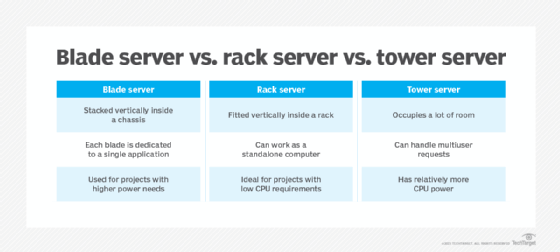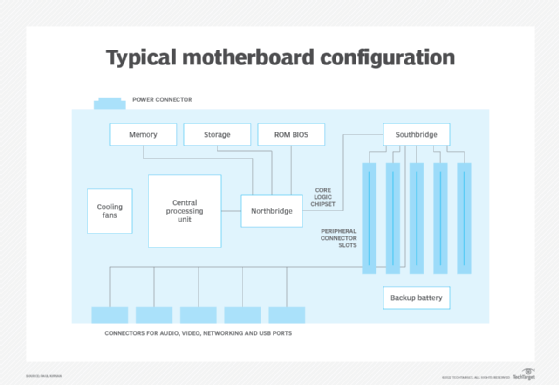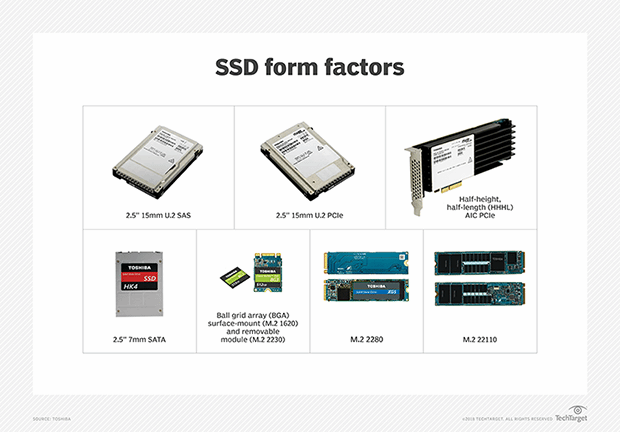form factor
What is form factor?
In computing, form factor refers to the size, configuration, shape, weight or physical arrangement of a computing device. In general, a device's physical characteristics refer to its form factor.
Form factor is commonly used to describe the design, size and/or arrangement of a device, a computer case or chassis, or one of the device's internal components, such as a motherboard or a daughterboard.
It can also mean any of the following regarding a hardware component:
- Shape or layout.
- Dimensions.
- Connectors.
- Mounting types.
When used to refer to the size of a freestanding computer or other device, form factor is similar in meaning to footprint.
Over the years, smaller form factors of various components have emerged as computers have become smaller to accommodate users' demand for greater portability, more expansion and customization options, and easier system upgrades.
What is an example of form factor?
For example, a desktop's keyboard has a form factor that's incompatible with a laptop, simply because it is too large to fit into the laptop's smaller form factor. Of course, a keyboard is necessary, so device manufacturers design laptop keyboards with a smaller form factor than desktop keyboards that can be directly attached without any external wiring.
In general, the form factor of a hardware component depends on the size of the larger device that the component is a part of.
Importance of form factor
It's important to know the form factor of a device or component to ensure connection and integration compatibility. Since a computing system typically consists of multiple integrated components, their form factors must be compatible to ensure the product works correctly and that the various components function well together. Incompatible form factors can affect the system's operations or usability, or even damage other components.
Using standardized form factors is also important, especially when parts need to be interchanged or when the system needs to be expanded. Standardized and compatible form factors also play a role in enhancing user experiences. Form factors can affect a system's portability, aesthetics, power efficiency, space, ease of component installation or removal, and even customizability, all of which can enhance or detract from a user's experience.
Different types of form factors in computing
Computing devices or components -- servers, motherboards and memory -- are available in different form factors. For example, these are the most commonly used form factors for servers:
- Tower. A tower case can accommodate a few servers and includes a built-in power supply.
- Rackmount. A rackmount server, or simply a rack server, is placed in a small chassis and vertically stacked to save space in confined areas.
- Blade. A blade server is a thin server placed in a blade chassis; the chassis can hold six or more blade servers and fit into a standard 19-inch equipment rack.
- Microserver. A microserver is a small server built for space-constrained environments.

Common motherboard form factors include the following:
- Standard ATX. The most common motherboard form factor for desktops, with up to seven expansion slots and up to 10 mounting holes for easy expansions and upgrades.
- Micro-ATX. Smaller than the standard form factor, with up to four expansion slots and up to eight mounting holes.
- DTX. Motherboards with a width of 6.7 inches and up to two expansion slots.
- EATX. A larger form factor than standard ATX, usually included in specialized computers for gaming, graphic design, video editing, etc.
- ITX. Smaller than ATX and micro-ATX; usually used with small form factor computing units or low-power processors.
- Mini-ITX. The smallest possible ATX form factor, mini-ITX only has one expansion slot and four mounting holes.

The following are the most popular memory form factors:
- Single in-line memory module. SIMM consists of six to nine dynamic RAM or synchronous DRAM chips; both 30-pin and 72-pin modules are in use.
- Dual in-line memory module. DIMM is used for desktops, laptops and servers; it uses a 64-bit data path and 288-pin connectors.
- Small outline DIMM. A smaller version of DIMM with smaller dimensions, SODIMM is usually used in compact systems such as laptops.
Like servers, motherboards and memory chips, other computing components are available in various form factors. These include the following:
- Power supply units.
- Graphics cards.
- Solid-state drives.

Form factors of notebook computers
Notebook computers are a form factor unto themselves because they have the same "clamshell" form, are typically rectangular, and open to a keyboard on the flat surface and a screen on the top. Notebooks are available in a variety of form factors that identify a type of product and target market, such as the following:
- Ultrabook. This notebook category includes thin and light laptop computers designed to bridge the market gap between tablets and premium notebook PCs.
- Netbook. Netbooks are small, light, low-power notebook computers that have less processing power than a full-size laptop, but are still suitable for word processing, running a web browser and connecting wirelessly to the internet. Over the past decade or so, netbooks have largely been replaced by tablets with similar processing capabilities.
- Convertible tablet. These are computers that can function as either a standalone touchscreen tablet device or as a notebook with a physical keyboard.
Form factor in other contexts
Apart from computing, the term form factor is also used in other contexts.
In electric motor terminology, form factor is the amount of rectified current emitted from a direct current (DC) power source and is expressed as a ratio of the root-mean-square value of the current to the average current, or RMS/AV. If the form factor differs much from pure nonpulsating DC -- a value of 1.0 -- it indicates the possibility that motor and brush life will be shorter.
In particle physics, form factor is the scattering resulting from the shape of a particle. It measures the charge and magnetic‐moment distribution in that particle. Two related quantities are often mentioned in the context of a particle's form factor: form factor amplitude, which is the particle's 3D reciprocal-space; and form factor intensity or scattering intensity, which is the amount of radiation scattered at a particular angle.
In software engineering or programming, form factor usually refers to the size of the program or the amount of memory required to run the program effectively.
Servers come in different form factors and configurations. Take these factors into consideration when choosing new server hardware.
